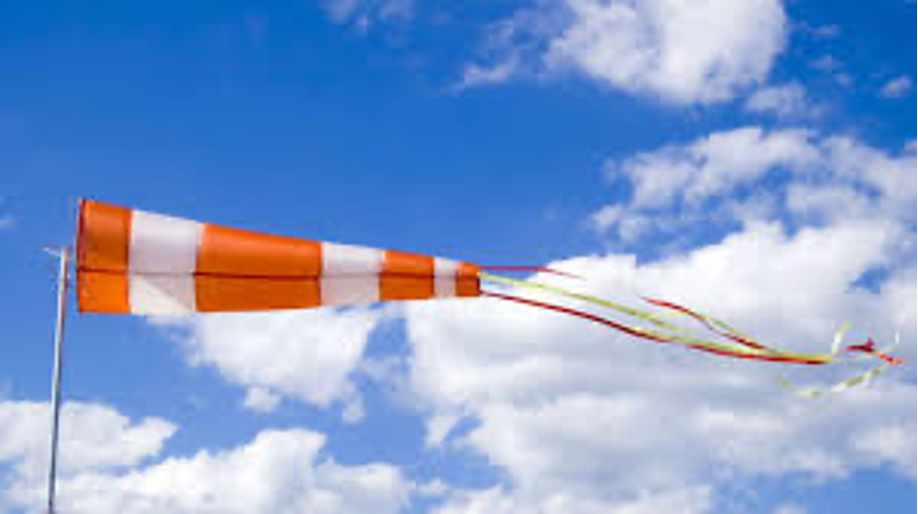The Nortada, the Portuguese Northern Wind, brought us to the Algarve. We have been here for a while now, happy victims of the Guadiana Glue. Since our wind generator broke down, we wanted to select a new one. Which one? In this article we compare the three most used quality wind turbines: Air Breeze, Superwind and SilentWind.
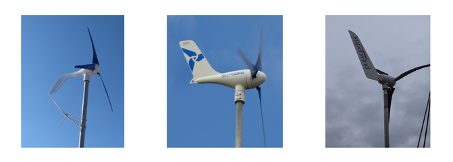
We compare these three wind generators because they are universal. They can handle all batteries, can be combined with solar panels and other generators, and they are available in 12, 24 and 48 Volt. They are often used on yachts and they are all good, high end generators.
We chose for the SilentWind for its light weight, low noise, the power in also the high range, and the low maintenance.
The yield is in the height!
If you really want a wind generator to deliver, then it needs height. Don’t put it on a 3 metre pole on your boat, but put it higher than 5,5 metre, away from wind obstacles. Then it delivers double, because that is where the wind blows.

This ‘higher-than-5,5’ metre rule dates from 17th century. They figured this out in the time that building high mills was difficult, while the wind in Holland was crucial for the industry there. In those days, the Zaanstreek was the innovation centre of Holland, the dominant and richest country of the world. It was full of windmills, for sawing wood, grinding grain, and they were pumping the water out of the polders around Amsterdam. They could use every sigh. This ‘higher-than-5,5-metre’ rule nowadays is interesting for us sailors.

Check the picture above. The wind blows from the left to the right. On the left side you see a diagram of the ‘clean’ wind. The wind is there if not too close to the surface. The wind blows over the buildings and creates turbulence above it. On the right side you see the influence of these obstacles. For good wind, you have to be far above that ‘stuff’. This also underlines the +5,5 meter rule from the 17th century, when obstacles in the field were not higher than the cattle and the grain. And this corresponds with our yacht: a hull on the water, with a railing and stuff on deck. So we’d better stick to that +5,5 meter rule.
If ever you want to remember anything about the yield of windmills: the height is essential. A cheap windmill put on 7 meter, gives a a far better yield than a high-end windmill put on 3,5 meter.
From here we go into the nuances and details.
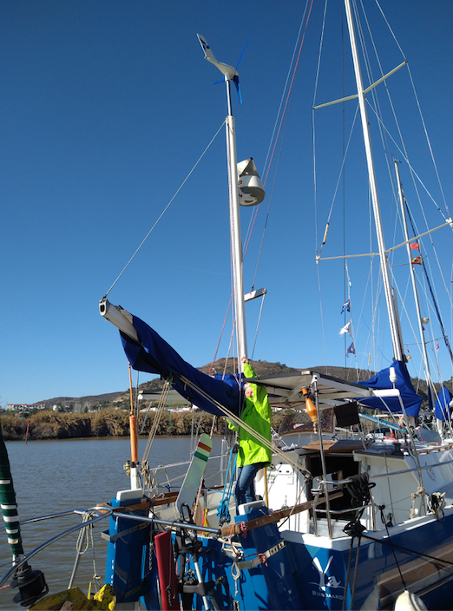
More height – less weight
A sailing yacht should not capsize. The ‘Ya’ is an ocean approved yacht and complies with the highest standard; even with the mast top blown into the waves she still self-righting. So, all high things on board are necessarily light things.
There are two pretty light wind generators. The lightest is the Air Breeze (5.9 kg). SilentWind a bit heavier (6,8 kg). Heaviest is the Superwind (11,5 kg).
The Superwind is too heavy for a yacht like the Ya; we would have to put it two times lower and this is close to nonsense. But it is a good turbine for a bigger yacht.
The power – it is in the range, not at the peak
The peak power number only gives an impression for a first orientation. All three wind generators are in the range of a couple of hundred Watts. Instead of the peak power, you must look at the power curves. Then you understand the power of a windmill and what suits you.
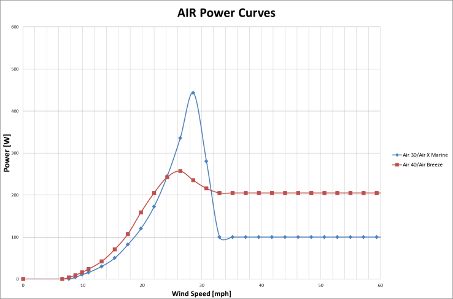
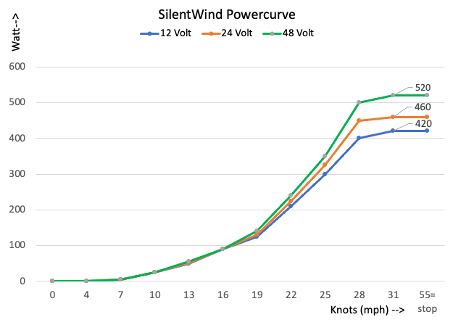
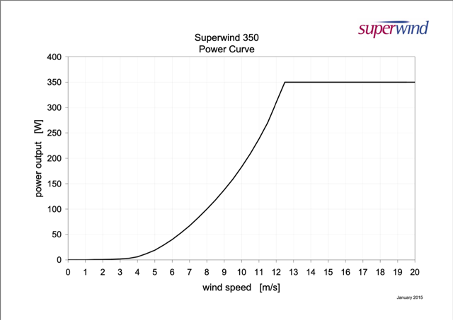
Shrieking, madness….and then silence
We are cruisers. We love nature and the silence. We want our wind generator to deliver energy, not the noise.
All three windgenerators have 3 blades. This is a compromise between efficiency and noise. Interested in the technological reasons why? Rosie explains it simple and straight here.
On the Ya we started with the Air Breeze with the standard blades. From the first cut-in, it started making noise. First you like it, because it delivers. But when it really starts delivering and nears the 15 knots of wind, the blades produce a high shrieking sound. The first neighbour started to complain. At 20 knots of wind the neighbours got angry.
Then we discovered the silent blades. Made in Portugal by SilentWind. A high-end product, just as the price of over 300 Euros. But it was worth every penny. Now the same Air Breeze was making a bit of a whistle till 10 knots, a more serious whistle with more speed, and when the wind is somewhere between 15 and 20 knots, the wind generator’s noise drowns into the ambient noise of the wind blowing through the rigging of the boat.

Now we have the SilentWind. When the rotation is slow and you listen well, you can hear the sound created by the magnets or the new bearings. At 8-12 knots you hear a light low whistle and when faster it becomes a friendly lower tone with more volume. When over 15 knots, the noise drowns into ambient wind noises.
The Superwind you will not hear from 20 knots of wind. I listened many times to this mill in several situations in light winds, and it is really low noise. But nothing beats the SilentWind.
Brakes and no brakes
All three can be switched off manually, for example when there is not enough wind. The switch simply makes a short circuit. The Air Breeze and SilentWind also use this short circuit brake to prevent too much speed, which is near hurricane. Before the blade tips would reach bullet speeds, spin out of control and could be ripped from the turbine, the electronics create a short circuit and the blades will slow down to a near stop.
The SuperWind solves this differently, with smart blades. From 25 knots the blades automatically start to adjust their pitch and the rotation speed will not increase. So, in a severe storm, when there is not much sun for your solar panels, the Superwind keeps on generating energy for you.
One could say that the extra moving parts of the Superwind blades have more chance to fail than the simple fixed set of blades of SilentWind and Air Breeze. But this elegant mechanical solution is perhaps safer than the electronic shut off, because also electronics can fail.
Every windmill can be pre-set to stop generating electricity when a certain voltage is reached. Air Breeze and SilentWind simply use the same short circuit brake to prevent overcharging. Since Superwind does not have this brake, all the excess electricity is regulated to go into big capacitators that will get warm, or even hot, and will be cooled by the air around it in your engine room. I don’t like that for leisure sailors. In wintertime the consumption is low and the battery full, while the winds are strong. Then, when nobody is on board, the capacitators in the engine room or cabin cupboard get very hot. It doesn’t give me a safe feeling.
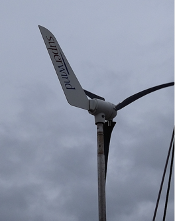
Keep your maintenance low
Superwind designed the mill to keep the maintenance low. The blade pitch against too much RPMs and the double bearings are two examples. Great, but all together it became too heavy for us.
Our Air Breeze broke down. It did not work properly in the medium wind range. Was it the circuit board? We lowered the mast, unmounted the shaft, et cetera and took the circuit board out. We sent it to the service. It was renewed. We remounted everything, put the mast up again, and it ran well. One week later, the same problem. We lowered the mast… to cut a long story short, we lowered and raised the mizzen mast six times (Thanks to Piet, Tulga, IJsbrand, Henk, Jaap, Mick, Inez and others). We also renewed a chip up there, and other things.
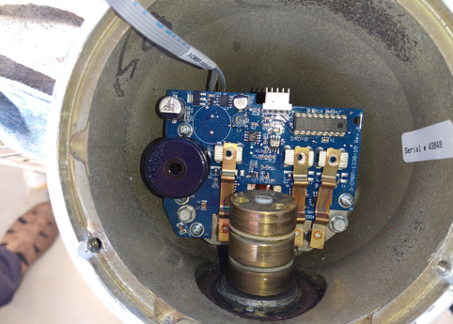
Then one morning, we were on the river Guadiana and I saw a strong breeze running over the water towards us. I looked up the mizzen, and saw the Air Breeze hardly responding. I knew, this was its last breeze. Our Air Breeze was no more. We declared it our late Air Breeze.
After these ups and downs, I learned what had to be down. That’s chips, diodes and circuit boards. They don’t belong in the top of your mast, where the rain and moist and salt from the sea reign and you can’t look after it. If you want to keep your maintenance low, then keep it low. Superwind and SilentWind put the electronics in a box (converter or MPPT) and you mount that box in your engine room or cabin or any other dry place. Ofcourse it can break down, but in that environment the chance is smaller and the (preventive) maintenance is easy there.
Why the SilentWind is Ya’s pick
Weight=height. On the Ya the windmill can be put on 7 meters high, on the mizzen mast. If…. the generator doesn’t weigh too much. The 6 kilograms of the Air Breeze and the Silentwind don’t influence the stability of Ya. The Superwind with its 11,5 kilograms should be mounted half way. But on 3-4 meters height there is simply not enough wind to justify such a high-quality piece of equipment.
Silence. All three are reasonably silent. (if the Air Breeze has the low noise blades). On the other hand, if you are on anchor somewhere in the middle of a creek enjoying the singing of the godwit, bluefinch and specked spoonbill, and then a light breeze picks up, you will enjoy the off-switch of your wind generator.
Which is the best on low noise? My private opinion is that the SilentWind -what’s in a name- beats the Superwind.
Power range. All three deliver well in the critical wind range we like to sail in, or when we anchor in a more open bay. The Air Breeze is best in ‘our’ leisure sailors wind range and falls back in the higher regions. The Superwind is doing about the same, but is cut on 350Watts from 25 knots. The SilientWind continues in the high range. We are also interested in the production in stronger winds, when the weather is bad and our solar panels don’t deliver. Then the 12 Volt delivers continually 420 Watts. The 48 Volt version -which is of our interest- delivers even 520 Watt, so much better than Superwind (350 Watt) and the Air Breeze (200 Watts). Our battery capacity is big enough, it is seldom full, so let it all come in, SilentWind!
Regulation You can look deep into the regulation. We love KISS, and then the Air Breeze comes close with a simple circuit board built in the mill. SilentWind’s regulation is based on the core business of the wind generator: to take all energy it can get from that wind, from the cut-in speed to the safety limit at gale wind. The only disadvantage is that you have a big MPPT in your engine room.
I do like the blade pitch solution of the Superwind to keep on running smooth in even a hurricane. But I don’t like that the mill keeps running when the battery is full and the capacitators can get hot. Batteries are full when there is no consumption, so mostly when nobody is there. Then we don’t want critical hot things on board.
Low maintenance. A special word to Superwind. They have put a lot of attention to durability and low maintenance. Unfortunately, this is also the reason that it became too heavy to be effective on the Ya.
I see maintenance, preventive or repairs, as a daily custom for the sailor. But our Air Breeze signed its death warrant when it had to be lowered from the mizzen for the 8th time to check the circuitboard. The SilentWind (and also Superwind) keeps this delicate stuff in the converter or MPPT, to be mounted low, e.g. in your engine room.
Conclusion: We chose SilentWind. Please mail info@fossilfreearoundtheworld.org if you have any comment. We’re curious what you choose and why!

